Invented by Heyue Zhou, John Dixon Gray, Sorrento Therapeutics Inc
One of the main reasons for the increasing interest in LAG3 as a therapeutic target is its ability to suppress immune responses. When LAG3 binds to its ligand, MHC class II molecules, it inhibits T cell activation and proliferation, leading to immune tolerance. This mechanism is beneficial in preventing excessive immune responses that can cause tissue damage and autoimmune diseases. However, in certain conditions, such as cancer, LAG3 can be exploited by tumor cells to evade immune surveillance and promote tumor growth.
Antibody therapeutics that bind LAG3 aim to block its inhibitory function and enhance anti-tumor immune responses. By blocking the interaction between LAG3 and MHC class II molecules, these antibodies can restore T cell activation and proliferation, leading to enhanced tumor cell killing. Additionally, LAG3 antibodies can also modulate other immune cells, such as dendritic cells and regulatory T cells, further enhancing the anti-tumor immune response.
The potential of LAG3 as a therapeutic target has been demonstrated in preclinical and clinical studies. Several LAG3-targeting antibodies have shown promising results in early-phase clinical trials, both as monotherapies and in combination with other immunotherapies, such as PD-1/PD-L1 inhibitors. These studies have shown improved response rates and prolonged survival in patients with various types of cancer, including melanoma, lung cancer, and renal cell carcinoma.
The market for antibody therapeutics that bind LAG3 is expected to witness significant growth in the coming years. According to a report by Grand View Research, the global immune checkpoint inhibitors market, which includes LAG3-targeting antibodies, is projected to reach $56.9 billion by 2028, growing at a compound annual growth rate of 14.6%. The increasing prevalence of cancer and the growing demand for effective immunotherapies are the key factors driving this market growth.
Several pharmaceutical companies are actively developing LAG3-targeting antibodies. Bristol Myers Squibb’s relatlimab and Merck’s vibostolimab are among the most advanced candidates in clinical development. Additionally, numerous biotechnology companies, such as Arcus Biosciences, Immutep, and I-Mab Biopharma, are also working on LAG3-targeting antibodies, either as standalone therapies or in combination with other immune checkpoint inhibitors.
In conclusion, the market for antibody therapeutics that bind LAG3 is witnessing rapid growth, driven by the potential of targeting this immune checkpoint receptor in the treatment of cancer and autoimmune disorders. The promising results from preclinical and clinical studies, along with the increasing prevalence of cancer and the demand for effective immunotherapies, are fueling the development of LAG3-targeting antibodies. As more research and clinical trials are conducted, it is expected that LAG3-targeting antibodies will become an integral part of the immunotherapy landscape, offering new treatment options for patients in need.
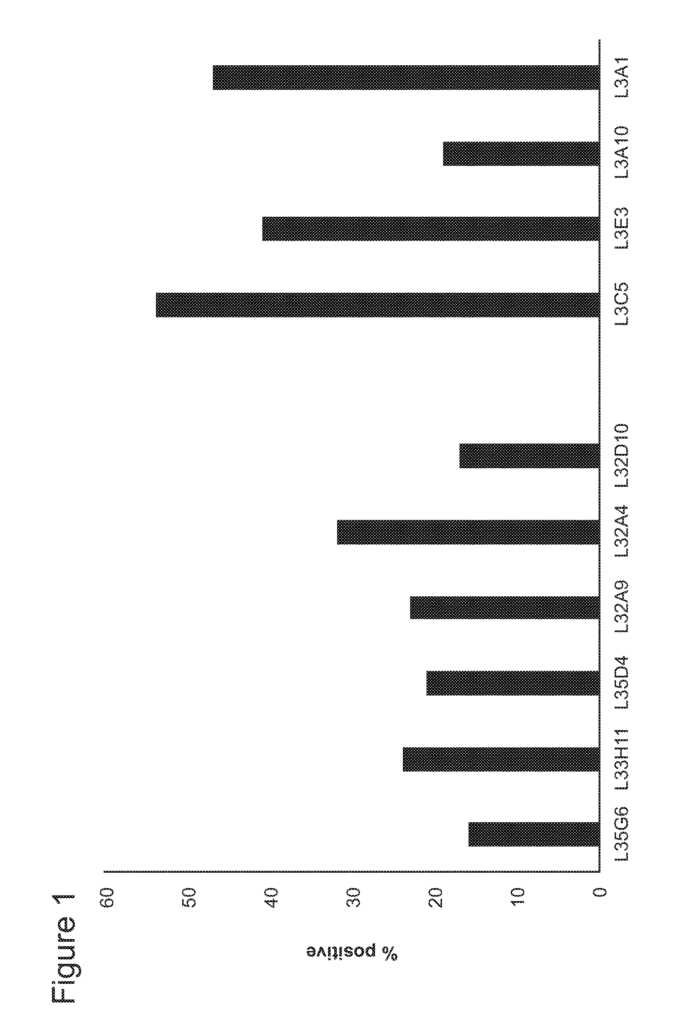
The Sorrento Therapeutics Inc invention works as follows
Compositions and methods related to or derived by anti-LAG3 antibody are disclosed. There are also disclosed LAG3 binding polypeptides that contain fragments from antibodies bound to LAG3, as well as fragments, derivatives, and derivatives of antibodies bound to LAG3. There are also nucleic acid encoding these antibodies, polypeptides and antibody fragments. Cells containing such polynucleotides. Methods of making, using and treating such antibodies.
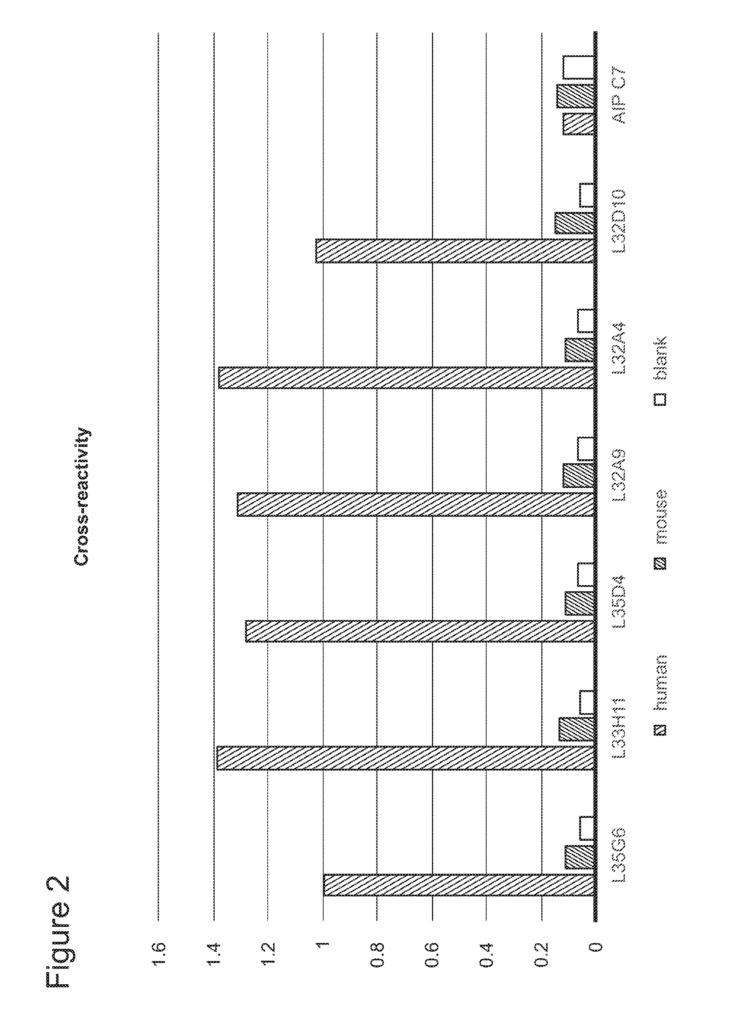
Background for Antibody Therapeutics that Bind LAG3
Lymphocyte activation gene-3″ (also called CD223) is a member in the supergene family of immunoglobulins and structurally and genetically related with CD4. LAG3 does not appear on resting lymphocytes in peripheral blood, but it is found on T and NK cells that are activated. LAG3 is encoded by a membrane-protein gene on the distal arm of chromosome 12 near the CD4 genes, which suggests that the LAG3 protein may have evolved via gene duplication. (1990) J. Exp. Med. 171:1393-1405).
LAG3 interacts with MHC Class II molecules in a similar way to CD4, but unlike CD4, LAG3 doesn’t interact with the human immune deficiency virus (HIV) gp120 proteins” (Baixeras and al. (1992) J. Exp. Med. 176:327-337). Studies using a soluble LAG3 immuneglobulin fusion (sLAG3Ig), demonstrated the direct and specific binding between LAG3 and MHC class II at the cell surface. (Huard et. al. (1996) Eur. J. Immunol. 26:1180-1186).
In in vitro studies on antigen-specific responses to T cells, adding anti-LAG3 antibody led to an increase in T cell proliferation and expression of activation markers such as CD25. It also increased the concentration of cytokines like interferon-gamma, interleukin-4 and other cytokines, supporting the role of the LAG3/MHC Class II interaction in downregulating antigen dependent stimulation of CD4+T lymphocytes. (1994) Eur. J. Immunol. 24:3216-3221). The intra-cytoplasmic LAG3 region has been shown to interact with LAP (a signal transduction protein thought to be involved in the downregulation the CD3/TCR activated pathway) (Iouzalen and al. (2001) Eur. J. Immunol. 31:2885-2891). 31:2885-2891). Immunity 21 (2004):503-513. Further, LAG3 was shown to negatively affect T cell homeostasis in T cell dependent and independent mechanisms by regulatory T-cells (Workman et al. (2005) J. Immunol. 174:688-695).
In certain circumstances, LAG3 has also been shown to have an immunostimulatory effect. LAG3 transfected cancer cells were transplanted in syngeneic mice and showed a growth reduction or complete regression compared to the untransfected cells. This suggests that LAG3 expressed on tumor cells stimulated a response against tumors by activating antigen LAG3 presenting cell via MHC class 2 molecules (Prigent et. al.). (1999) Eur. J. Immunol. 29:3867-3876). In addition, it has been demonstrated that the soluble LAG3Ig fusion proteins stimulated both humoral and cellular immune responses in mice when given with an antigen. This indicates that soluble LAG3Ig could function as a vaccine (El Mir & Triebel, 2000 J. Immunol. 164:5583-5589). Further, it has been demonstrated that soluble human LAG3Ig can enhance in vitro the generation of type 1 tumor-specific immune response (Casati and al. Cancer Res. 66:4450-4460). Triebel, (2003) Trends Immunol reviews the functional activity of LAG3. 24:619-622. “In view of this, additional agents modulating the LAG3 activity are of interest.
The present invention provides novel antihuman LAG3 antibodies (hLAG3) and fragments thereof. The present invention is a novel anti-LAG3 antibody that can be beneficial, for example in that they act as immune checkpoint inhibitors and may also be used for immunotherapy to treat disorders such as cancer.
In a particular embodiment, the present disclosure discloses a fully-human antibody of the IgG type that binds a LAG3 peptide with a minimum binding affinity of 10?6M, and that has a heavy-chain variable domain sequence at least 95% identical to one amino acid sequence chosen from the group consisting SEQ ID No. SEQ ID No. 8, SEQ NO. SEQ NO. The light chain variable sequence is at least 95% identical with an amino acid sequence chosen from the group of SEQ NO. SEQ ID No. SEQ NO. SEQ NO. SEQ NO. SEQ NO. 7, SEQ NO. SEQ ID No. SEQ ID No. SEQ ID No. 14 and combinations thereof. In one embodiment the fully human antibodies has both a heavier chain and lighter chain, wherein the antibody contains a heavy-chain/light-chain variable domain sequence that is selected from a group consisting of SEQ ID No. 1/SEQ NO. 2 (called L35D4 herein), SEQ ID NO. 1/SEQ NO. 3 (called L35G6 herein), SEQ ID NO. 1/SEQID NO. 4 (called L33H11 herein), SEQ ID NO. 1/SEQID NO. 5 (called L32A9 herein), SEQ ID NO. 1/SEQID NO. 6 (called L32D10 herein), SEQ ID NO. 1/SEQID NO. 7 (called L32A4 herein), SEQ ID NO. 8/SEQ NO. 9 (called L3A1 herein), SEQ ID NO. 10/SEQ NO. 11 (called L3A10 herein), SEQ ID NO. SEQ ID NO. 13 (called L3C5 herein), SEQ ID NO. SEQ ID No. “14 (here called L3E3) and combinations thereof.
The present disclosure, in one embodiment, provides a Fab fragment fully human antibody, with a variable region of a heavy-chain and a similar variable region for a light-chain, wherein heavy-chain variable domain sequences are at least 95% identical amino acid sequences selected from the following group: SEQ ID No. 1, SEQ NO. 8, SEQ NO. SEQ NO. The light chain variable sequence is at least 95% identical with an amino acid sequence chosen from the group of SEQ NO. SEQ ID No. SEQ NO. SEQ NO. SEQ NO. SEQ NO. SEQ ID No. SEQ ID No. SEQ ID No. SEQ ID No. 14 and combinations thereof. In one embodiment, a fully human antibody Fab-fragment has both a region of heavy chain variable and a region of light chain variable. The antibody contains a heavy/light chain domain sequence that is selected from a group consisting SEQ ID No. 1/SEQ NO. 2, SEQ NO. SEQ ID NO. 3, SEQ NO. 1/SEQ NO. SEQ ID No. 1/SEQID NO. 5, SEQ NO. 1/SEQID NO. SEQ ID No. SEQ ID NO. SEQ ID No. 8, SEQ ID No. 9, SEQ NO. 10, SEQ ID No. 11/SEQ ID No. SEQ ID No. 12 13 and SEQ NO. SEQ ID No. 14 and combinations thereof.
In one embodiment, the present disclosure provides a single chain human antibody, having a variable domain region from a heavy chain and a variable domain region from a light chain and a peptide linker connecting the heavy chain and light chain variable domain regions, wherein the heavy chain variable domain sequence is at least 95% identical to an amino acid sequence selected from the group consisting of SEQ ID NO. 1, SEQ ID NO. 8, SEQ ID NO. 10, SEQ ID NO. 12, and has the light chain variable domain sequence is at least 95% identical to an amino acid sequence selected from the group consisting of SEQ ID NO. 2, SEQ ID NO. 3, SEQ ID NO. 4, SEQ ID NO. 5, SEQ ID NO. 6, SEQ ID NO. 7, SEQ ID NO. 9, SEQ ID NO. 11, SEQ ID NO. 13, SEQ ID NO. 14, and combinations thereof. In one embodiment, the fully human single chain antibody has both a heavy chain variable domain region and a light chain variable domain region, wherein the single chain fully human antibody has a heavy chain/light chain variable domain sequence selected from the group consisting of SEQ ID NO. 1/SEQ ID NO. 2, SEQ ID NO. 1/SEQ ID NO. 3, SEQ ID NO. 1/SEQ ID NO. 4, SEQ ID NO. 1/SEQ ID NO. 5, SEQ ID NO. 1/SEQ ID NO. 6, SEQ ID NO. 1/SEQ ID NO. 7, SEQ ID NO. 8/SEQ ID NO. 9, SEQ ID NO. 10/SEQ ID NO. 11, SEQ ID NO. 12/SEQ ID NO. 13, and SEQ ID NO. 8/SEQ ID NO. 14, and combinations thereof.
In one embodiment of the present disclosure, it also provides a method to treat a wide spectrum of mammalian diseases, such as cancers or infectious diseases, by administering an anti LAG3 polypeptide. The fully human antibody contains a heavy-chain variable domain sequence which is at least 95 percent identical to a selected amino acid sequence from the group of SEQ NO. 1, SEQ NO. SEQ ID No. SEQ NO. The light chain variable sequence is at least 95% identical with an amino acid sequence chosen from the group of SEQ NO. SEQ ID No. SEQ NO. SEQ NO. SEQ NO. SEQ NO. SEQ ID No. SEQ ID No. SEQ ID No. SEQ ID No. “14, and combinations thereof.
In one embodiment, a Fab fragment fully human antibody has a heavy chain variable domain that is at least 95 % identical to a selected amino acid sequence from the group consisting SEQ ID No. 1, SEQ NO. SEQ ID No. SEQ ID No. The light chain variable sequence must be at least 95% identical with an amino acid sequence chosen from the group consisting SEQ ID No. The sequences are SEQ ID No. SEQ NO. SEQ NO. SEQ NO. SEQ NO. SEQ ID No. SEQ ID No. 11, SEQ NO. SEQ ID No. “14, and combinations thereof.
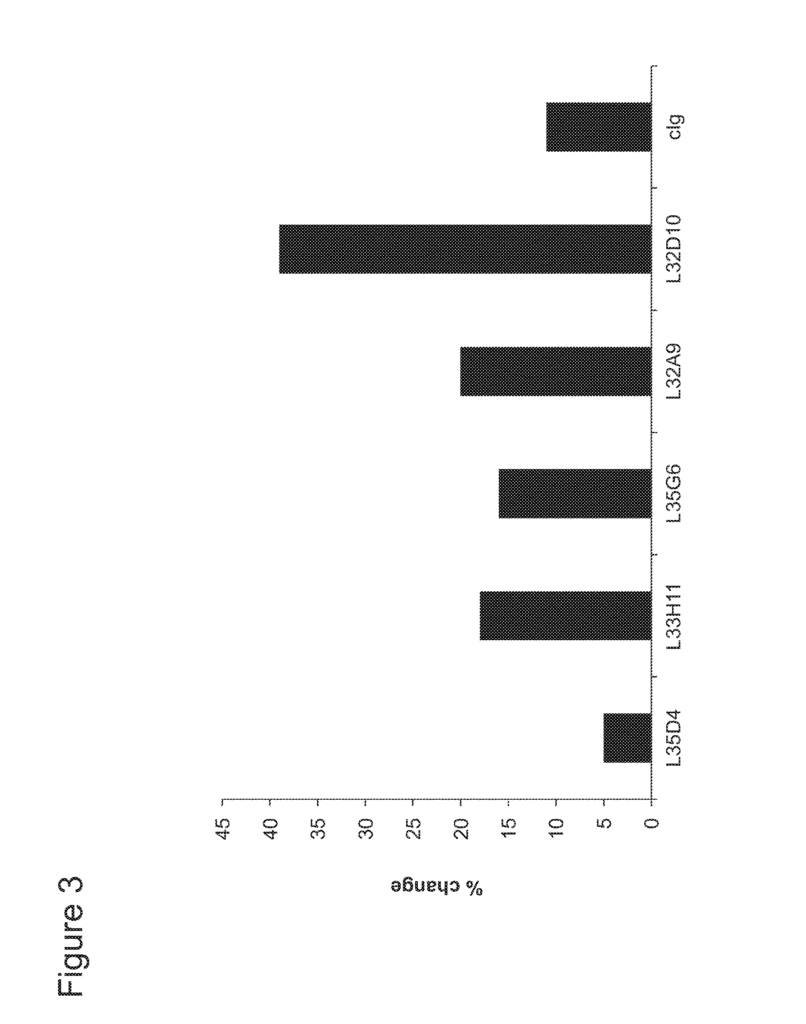
In one embodiment, the single chain human antibody has a heavy chain variable domain sequence that is at least 95% identical to an amino acid sequence selected from the group consisting of SEQ ID NO. 1, SEQ ID NO. 8, SEQ ID NO. 10, SEQ ID NO. 12, and combinations thereof, and has a light chain variable domain sequence that is at least 95% identical to an amino acid sequence selected from the group consisting of SEQ ID NO. 2, SEQ ID NO. 3, SEQ ID NO. 4, SEQ ID NO. 5, SEQ ID NO. 6, SEQ ID NO. 7, SEQ ID NO. 9, SEQ ID NO. 11, SEQ ID NO. 13, SEQ ID NO. 14, and combinations thereof.
In one embodiment the fully human antigen has both a heavy-chain variable domain and a lighter-chain variable domain, where the antibody contains a heavy-chain/light-chain variable domain sequence that is selected from a group consisting SEQ ID No. 1/SEQ NO. 2 (called L35D4 herein), SEQ ID NO. 1/SEQ NO. 3 (called L35G6 herein), SEQ ID NO. 1/SEQ NO. 4 (called L33H11 herein), SEQ ID NO. 1/SEQID NO. 5 (called L32A9 herein), SEQ ID NO. 1/SEQ NO. 6 (called L32D10 herein), SEQ ID NO. 1/SEQID NO. 7 (called L32A4 herein), SEQ ID NO. 8/SEQ NO. 9 (called L3A1 herein), SEQ ID NO. 10/SEQ NO. 11 (called L3A10 herein), SEQ ID NO. SEQ ID NO. 13 (called L3C5 herein), SEQ ID NO. SEQ ID No. 14 (called L3E3 in this document), and combinations of them. In one embodiment, a fully human single-chain antibody contains both a heavy-chain variable domain and a lighter chain variable region. The heavy-chain/light-chain variable domain sequence is selected from a group of SEQ ID No. 1/SEQ NO. 2, SEQ NO. 1/SEQ NO. 2, SEQ NO. SEQ ID NO. 3, SEQ NO. 1/SEQ NO. SEQ ID No. 1/SEQ NO. SEQ ID No. 1/SEQID NO. SEQ ID No. SEQ ID NO. 7, SEQ NO. 8, SEQ ID No. SEQ NO. 10, SEQ ID No. 11/SEQ ID NO. 12, SEQ ID No. 13 SEQ ID No. SEQ ID No. 8/SEQ NO. 14 and combinations thereof.
In one embodiment, a broad spectrum of mammalian diseases or autoimmune reactions is to be treated. This includes non-Hodgkin?s lymphoma(NHL), Burkitt?s lymphoma(BL), multiple Myeloma(MM), B-CLL, B-T acute lymphocytic (ALL), T-cell lymphoma and hairy cell leukemias (HCL), Hodgkin?s Lymphoma and chronic myeloid (CML), HL
In one embodiment of the invention, an isolated fully-human antibody of the IgG type that binds to the LAG3 epitope is provided. The antibody comprises: a heavy chains variable domain sequence which is at least 95 % identical to an amino acids sequence selected from a group consisting SEQ ID No. 1, SEQ NO. SEQ NO. SEQ ID No. A light chain variable sequence that is at most 95% identical to a sequence of amino acids selected from a group including SEQ ID No. SEQ ID No. SEQ NO. SEQ NO. SEQ NO. SEQ NO. SEQ ID No. SEQ ID No. SEQ ID No. 13 SEQ ID No. 14.
In one embodiment the fully human antigen contains a heavy-chain/light-chain variable domain sequence, selected from a group consisting SEQ ID No. 1/SEQ NO. 2 (L35D4) SEQ ID No. 1/SEQ NO. 3 (L35G6) SEQ ID No. 1/SEQ NO. 4 (L33H11), ID SEQ No. 1/SEQID NO. 5 (L32A9) SEQ ID No. 1/SEQID NO. 6 (L32D10) SEQ ID No. 1/SEQ NO. 7 (L32A4). SEQ ID No. 8/SEQ NO. SEQ ID No. 9 (L3A1) 10/SEQ NO. SEQ ID No. 11 (L3A10) SEQ ID NO. 13 (L3C5) and SEQ NO. SEQ ID No. 14 (L3E3).
In one embodiment of the invention, an anti-LAG3 Fab fragment is a fully human antibody that contains a heavy chain variable sequence, which is at least 95 % identical to an amino acids sequence selected from. 1, SEQ NO. 8, SEQ NO. SEQ ID No. The light chain variable sequence is at least 95% identical with an amino acid sequence chosen from the group of SEQ NO. 2, SEQ NO. SEQ NO. SEQ NO. SEQ NO. 6, SEQ NO. SEQ ID No. SEQ ID No. 11, SEQ NO. 13 and SEQ NO. 14. In one embodiment, a fully human antibody fragment Fab contains a variable domain sequence of the heavy chain/light chains selected from selec-tion among SEQ ID No. 1/SEQ NO. 2, SEQ NO. SEQ ID NO. 3, SEQ NO. 1/SEQ NO. SEQ ID No. 1/SEQID NO. 5, SEQ NO. 1/SEQID NO. 6, SEQ NO. SEQ ID NO. SEQ ID No. 8, SEQ ID No. 9, SEQ NO. 10, SEQ ID No. 11/SEQ ID No. SEQ ID No. 12 13 and SEQ NO. SEQ ID No. 14.
In one embodiment of the invention, an anti-LAG3 human single chain antibody is provided that comprises a heavy chains variable domain and light chains variable domain, which are linked by a peptide, wherein heavy chain variables domain contains an amino acids sequence that is at minimum 95% identical to a selected amino acid from the group consisting SEQ ID No. 1, SEQ NO. SEQ NO. SEQ ID No. The light chain variable domain consists of an amino-acid sequence that is at most 95% identical to a sequence chosen from the group consisting SEQ ID No. SEQ ID No. SEQ NO. SEQ NO. SEQ NO. SEQ NO. SEQ ID No. SEQ ID No. SEQ NO. SEQ ID No. 14.
In one embodiment the single chain human antibody contains a heavy-chain/light-chain variable domain sequence chosen from the group consisting SEQ ID No. 1/SEQ NO. SEQ ID No. SEQ ID NO. SEQ ID No. 1/SEQ NO. SEQ ID No. 1/SEQ NO. SEQ ID No. 1/SEQID NO. 6, SEQ NO. SEQ ID NO. SEQ ID No. 8, SEQ ID No. SEQ NO. 10, SEQ ID No. 11/SEQ ID No. SEQ ID No. 12 13 and SEQ NO. SEQ ID No. 14.
In one embodiment of the invention, an isolated antihuman LAG3 antibody (hLAG3), or antigen-binding fraction thereof, is provided. It contains a heavy-chain variable domain containing complementarity-determining regions (CDRs), as described in the heavy-chain variable domain amino-acid sequence, selected from. 1, SEQ NO. SEQ NO. SEQ ID No. The light chain variable domain comprises CDRs, as described in an amino acid sequence of the light chain variable region selected from SEQ ID No. SEQ ID No. SEQ NO. SEQ NO. SEQ NO. SEQ NO. SEQ ID No. SEQ ID No. SEQ NO. 13 and SEQ NO. 14. The heavy chain variable domain can be composed of an amino-acid sequence that is at minimum 95% identical to a sequence chosen from the group of SEQID NO. 1, SEQ NO. 8, SEQ NO. SEQ ID No. The light chain variable domain consists of an amino-acid sequence that is at most 95% identical to a sequence chosen from the group consisting SEQ ID No. 2, SEQ NO. SEQ NO. SEQ NO. SEQ NO. SEQ NO. SEQ ID No. SEQ ID No. SEQ ID No. 11, SEQ ID No. 14. In one embodiment the heavy chain variable domain consists of an amino acid sequence chosen from the group consisting SEQ ID No. In one embodiment, the heavy chain variable domain comprises an amino acid sequence selected from the group consisting of SEQ ID No. SEQ NO. SEQ ID No. The light chain variable domain consists of an amino acid sequence chosen from the group consisting SEQ ID No. SEQ ID No. SEQ NO. SEQ NO. SEQ NO. SEQ NO. SEQ ID No. SEQ ID No. SEQ ID No. 13 SEQ ID No. 14.
The present invention also features an isolated antihuman LAG3 antibody or antigen-binding fraction thereof. This includes a heavy-chain variable domain consisting of a CDR1 set (CDR1, CDR2, CDR3) chosen from the following SEQID Nos.
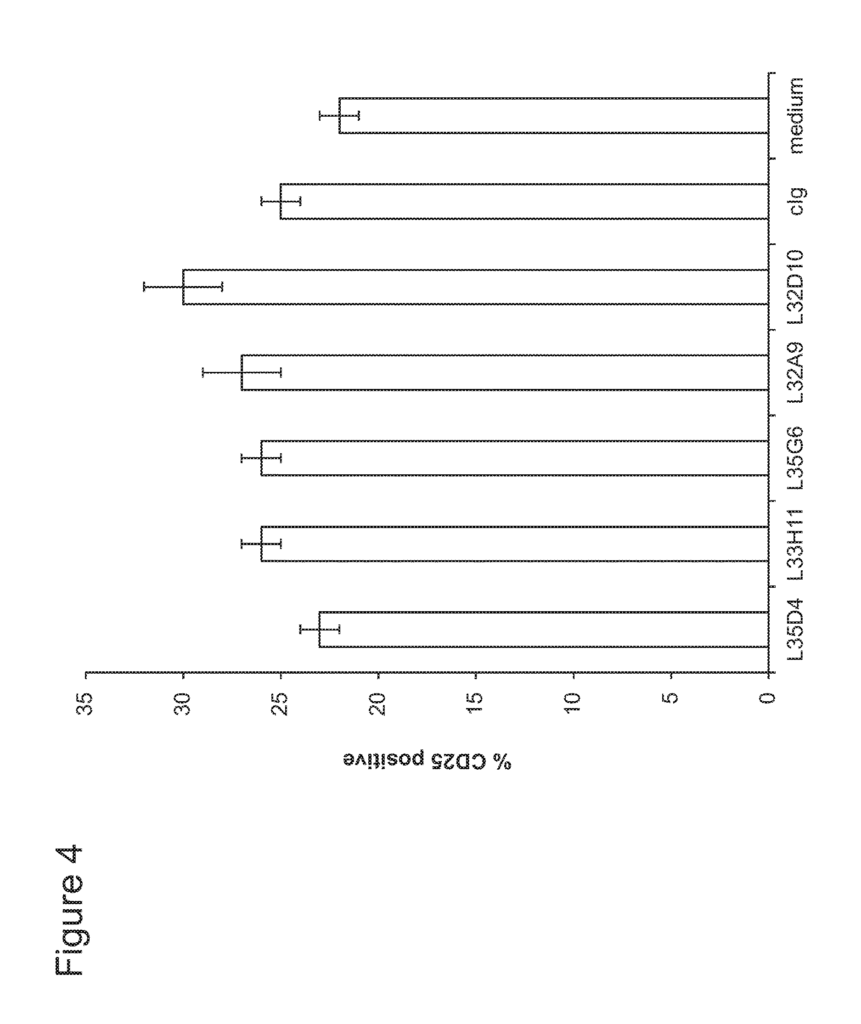
The antibody can be described as having a heavy-chain CDR/light-chain CDR combination selected from the following: the heavy-chain CDR/light-chain CDR combination of SEQ Nos 15, 16, 17, and 18, and light-chain CDR/light chain domain of 19, 20, and 21; heavy and light chains CDR/light chain domain of 25, 26, and 29, the medium and heavy chains CDR/light chain domain of 15, 16, 17, and light, light, light, light, light, light, light, light, light
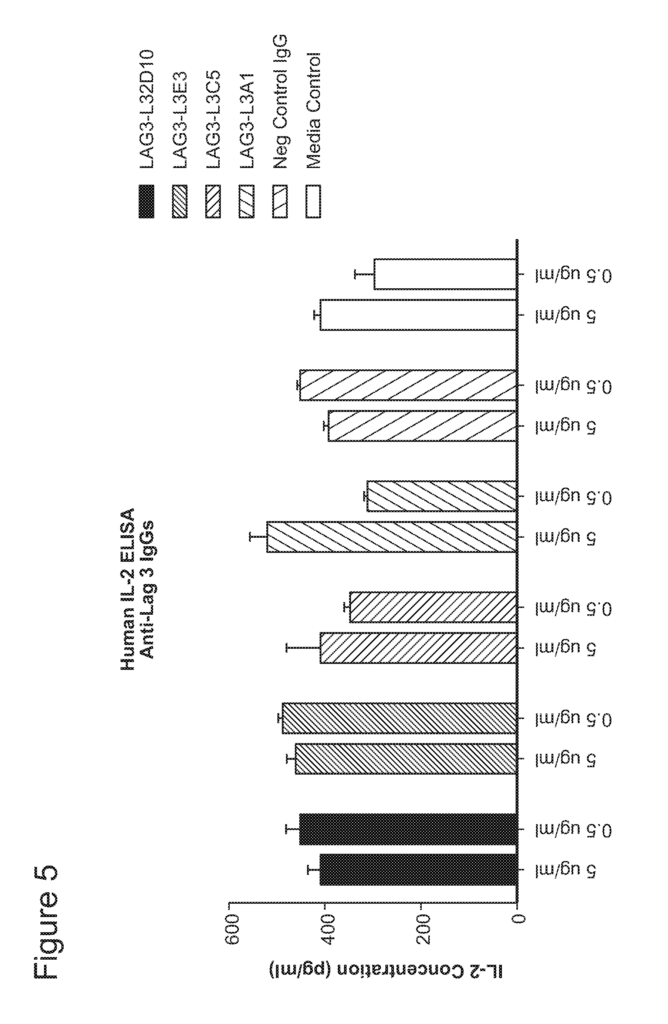
Click here to view the patent on Google Patents.
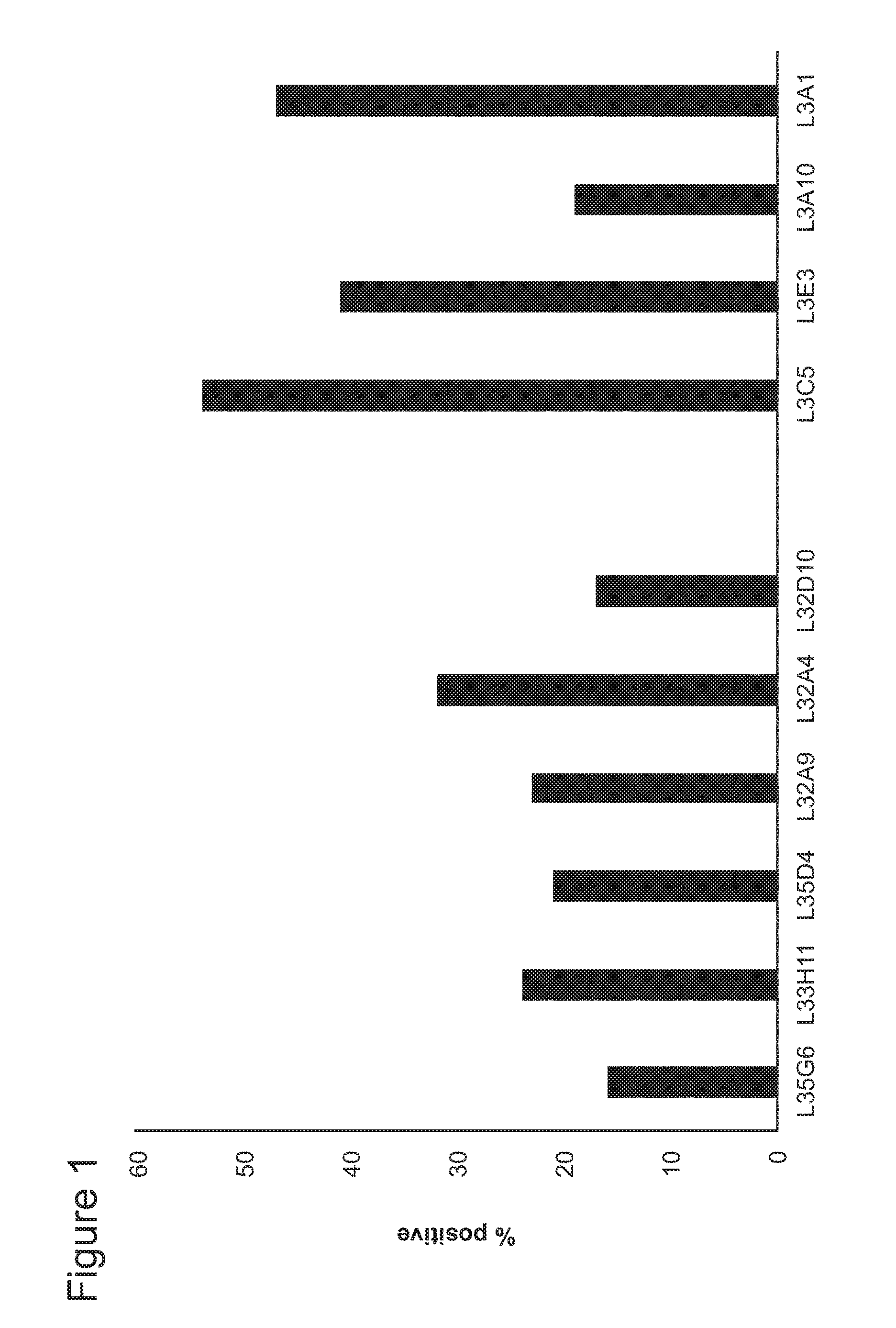
Leave a Reply